When deciding between pills and injections, discover the stark differences in absorption rates that could transform your treatment's effectiveness.
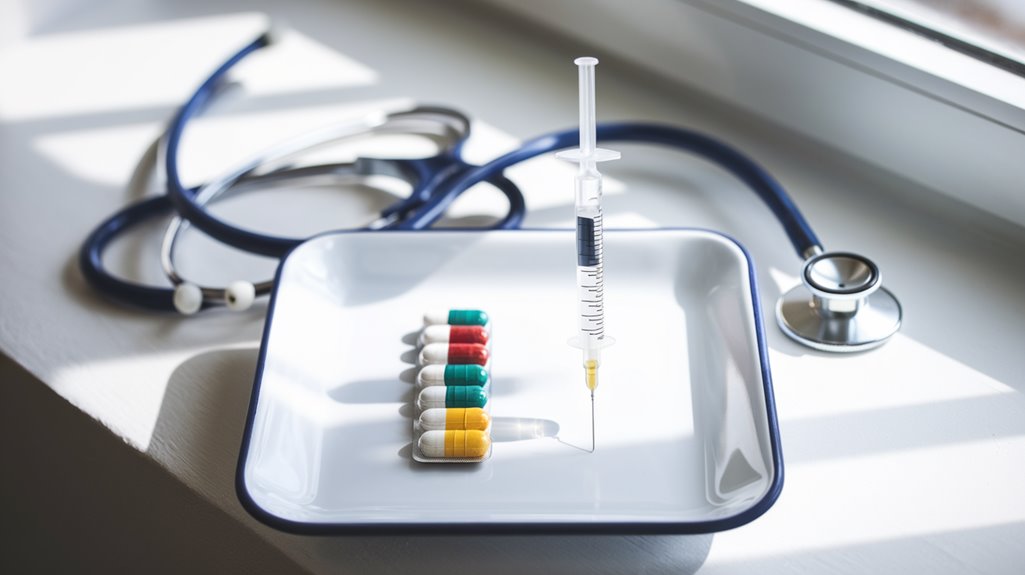
When choosing between pills and injections, you'll need to navigate significant differences in absorption rates, with injections providing 100% bioavailability compared to oral medications' typical 50-85% absorption through the digestive system. Injections offer faster therapeutic effects but come with considerations like needle anxiety and potential injection site pain. While pills provide convenience, they may require more frequent dosing and cause gastrointestinal issues. Your ultimate choice depends on factors like cost, comfort level, and treatment urgency – factors that can substantially impact your health outcomes.
When comparing pills and injections, the scientific evidence clearly demonstrates that injectable medications provide faster therapeutic effects due to their direct entry into the bloodstream. Unlike tablets that must first navigate through your digestive system and liver, injected medications bypass these barriers completely, delivering immediate therapeutic action.
Injectable therapies offer a significant advantage through 100% nutrient absorption when administered intravenously. You'll find that injectables maintain more consistent blood plasma levels, which can greatly improve treatment outcomes. This is particularly evident in conditions like vitamin deficiencies and diabetes, where digestive enzymes might compromise oral medications' effectiveness. For alcohol and opioid use disorders, research confirms that injectable treatments outperform oral alternatives in randomized controlled trials.
While the effectiveness of any medication isn't solely determined by its delivery method, you'll need to take into account that some substances, like insulin, simply can't survive the digestive process. In these cases, injections aren't just faster – they're essential for achieving the desired therapeutic effect.
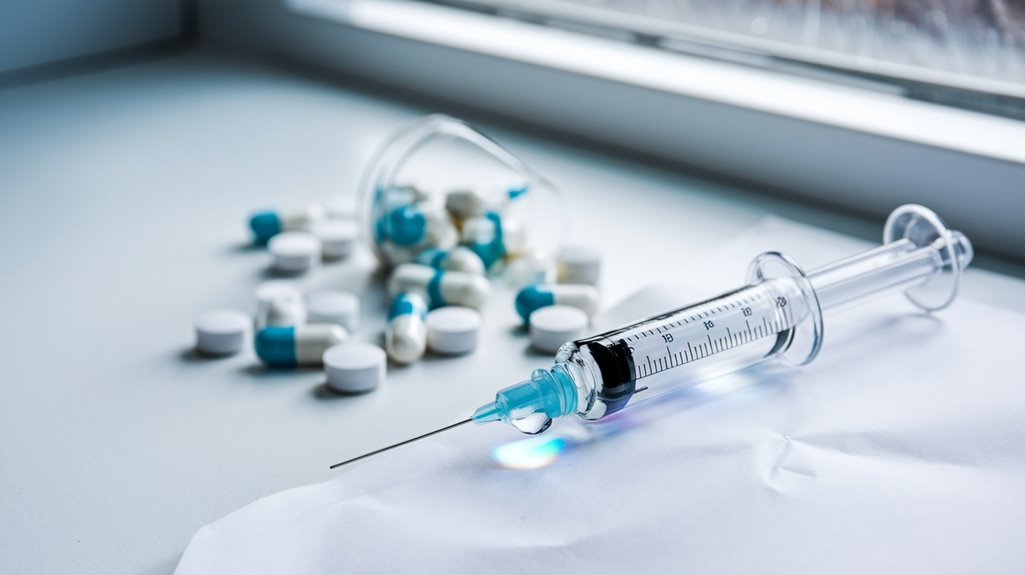
If you're apprehensive about injections, you'll need to weigh needle anxiety against the superior localized pain control that injectable medications can provide over oral pills. Managing injection site discomfort through proper technique and post-injection care becomes essential, especially when receiving treatments like corticosteroid or trigger point injections. Your daily comfort level may improve more with injections than pills, as targeted treatments can provide longer-lasting relief with fewer systemic side effects. For patients seeking oral medication options, NSAIDs and acetaminophen are recommended first-line treatments for mild to moderate pain management.
Although needle fear and phobia affect a considerable portion of the population – with 25% of adults and 66% of children experiencing anxiety about injections – the psychological impact extends beyond mere discomfort. Your fear likely stems from anxiety (96.1%) and pain anticipation (95.5%), which can considerably influence your healthcare decisions.
While pills offer a needle-free alternative, untreated needle phobia can lead you to avoid essential medical treatments that aren't available in oral form. You'll find that larger needles (23G) cause more pain (63%) compared to smaller ones (32G at 31%), but modern healthcare offers solutions. Transitioning to ultra-thin needles has shown a 22% reduction in perceived pain during injections. If you're struggling with needle anxiety, consider requesting smaller gauge needles, bringing a support person, or using distraction techniques. These strategies, combined with understanding healthcare providers, can help you manage your fear effectively.
Managing injection site pain requires a thorough approach that begins well before the needle touches your skin. You'll want to start by applying ice packs 15 minutes before the injection and ensuring your medication is at room temperature. Consider using prescribed numbing creams for additional comfort. Deep breathing exercises can help calm your nerves.
Post-injection, you've got several effective options to minimize discomfort. Apply cold packs to reduce swelling and take over-the-counter pain relievers as needed. Don't skip proper site rotation – it's essential for preventing tissue damage and reducing pain. Gentle massage can help disperse medication and ease muscle tension.
Watch for warning signs like severe pain, fever, or unusual swelling – they require immediate medical attention. If you experience difficulty breathing or swelling of the face or throat, don't wait – seek emergency care immediately.
When considering daily comfort, both pills and injections present distinct challenges and benefits that greatly impact quality of life. Pills require strict daily timing and can cause persistent gastrointestinal issues, while injections offer less frequent dosing but may involve temporary site discomfort. Your psychological comfort plays a significant role – needle aversion might make pills preferable, while others find weekly injections less burdensome than daily tablets. Clinical trials indicate that participants who received once-weekly injections experienced up to 15% body weight reduction, making any temporary discomfort worth considering.
Oral medications demand consistent daily routines and precise timing
Your lifestyle and personal preferences will ultimately determine which method aligns better with your daily comfort needs.
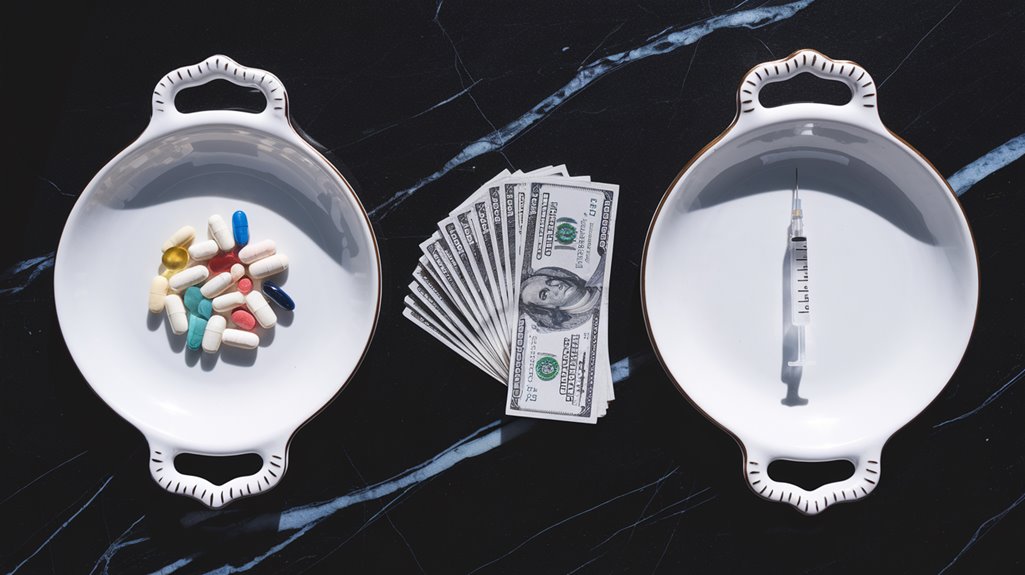
Understanding the cost differences between weight loss pills and injections reveals a complex financial landscape shaped by insurance coverage, geographical location, and medication type. You'll generally find pills like Rybelsus priced at $936 monthly, while injections range from $250 to $1,500 without insurance. Most insurance providers require prior authorization before approving coverage for these medications.
| Medication Type | U.S. Price (Monthly) | With Insurance |
|---|---|---|
| Oral (Rybelsus) | $936 | $25-$100 |
| Wegovy Injection | $1,349 | $0-$25* |
| Saxenda Injection | $1,200-$1,500 | $25-$100 |
| Compounded Options | $249-$254 | Not covered |
Your location greatly impacts costs. U.S. prices for these medications are typically five times higher than in countries like Japan or Germany. If you're uninsured, consider compounded versions starting at $249 monthly. Insurance coverage and manufacturer savings programs can dramatically reduce your costs, potentially to as little as $25 monthly for either format.
*With manufacturer savings programs
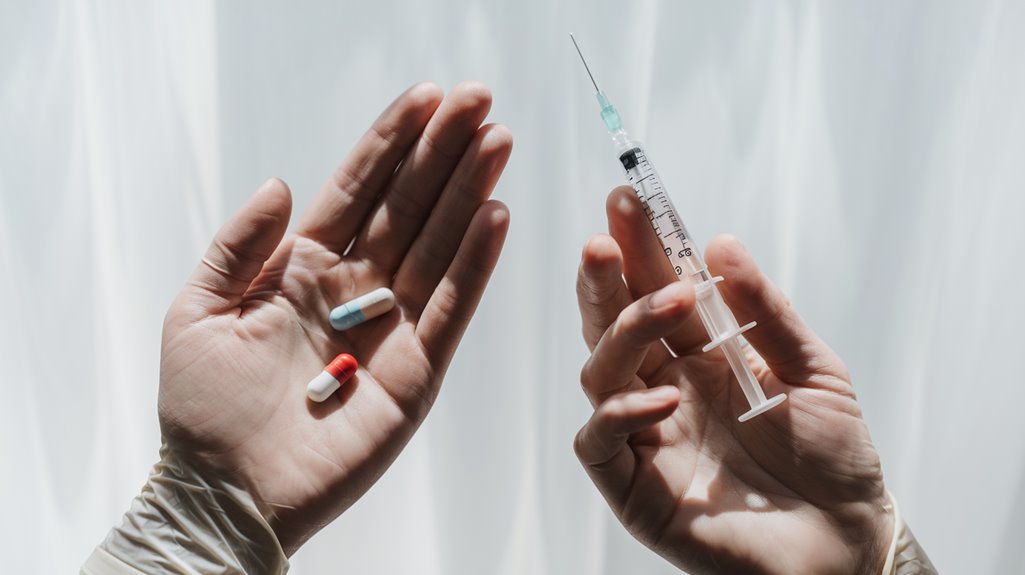
Doctors carefully weigh several key factors when choosing between pills and injections for your treatment plan. They'll consider the treatment's proven effectiveness, how often you'll need to take it, potential side effects, and your likelihood of sticking with the prescribed regimen. For MS patients specifically, your doctor's decision often revolves around the medication's ability to prevent relapses and slow disability progression. Research shows that 76.5% of patients initially prefer daily oral medications over weekly injectable options.
The frequency of doses can be just as significant as the medication's effectiveness. While some patients might prefer a daily pill, others may benefit more from less frequent injections. Your doctor will also factor in your tolerance for potential side effects and any concerns about needle anxiety or injection fatigue.
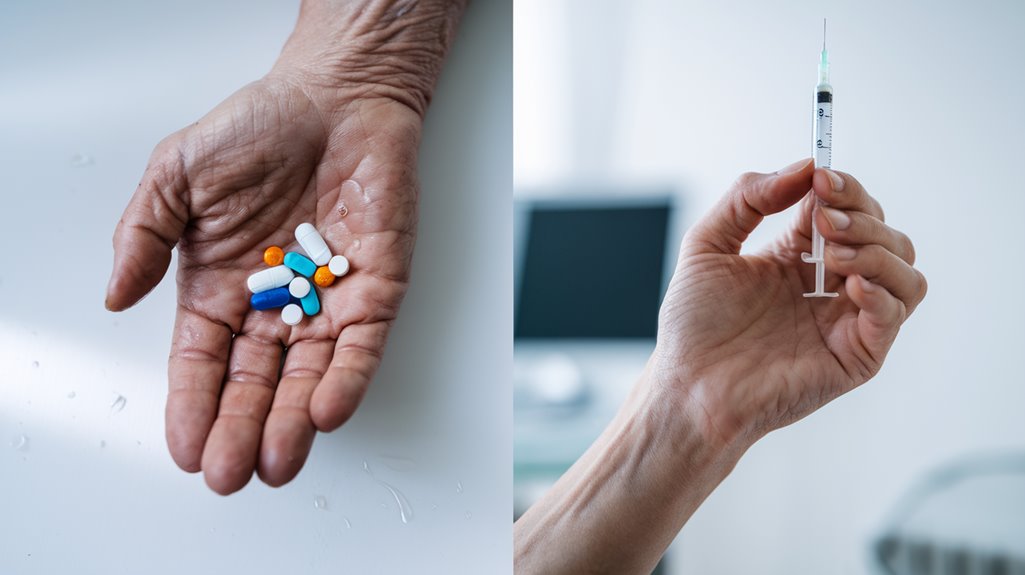
The real experiences of patients reveal both stunning successes and cautionary tales in the ongoing debate between pills and injections. You'll find stories of life-changing victories, from veterans overcoming addiction through injectable treatments to patients achieving sustained weight loss with oral medications. Yet you'll also encounter sobering accounts of struggles, including battles with pill dependency and unexpected complications from both delivery methods. Patients with bone infections had encouraging recoveries using pills, with a notably shorter hospital stay compared to those receiving injections.
Misguided attempts at finding miracle cures have led to devastating consequences for patients seeking alternative treatments. MMS, promoted by the Genesis II Church, proved fatal when a 56-year-old woman died from sodium chlorite poisoning. Sylvia Nash had been sailing worldwide since 2004 before her tragic death from MMS consumption. Stories like Lindsey Freeman's rare Kaposiform lymphangiomatosis and Birch Williams's untreated strokes demonstrate the complexity of medical interventions and risks of delayed care.
Remarkable advances in both oral and injectable medications have transformed treatment outcomes for patients with psoriasis and diabetes. You'll find oral medications like methotrexate and PDE4 inhibitors offering systemic treatment for psoriasis, while newer biologics provide targeted therapy through injections. For diabetes management, you've got options ranging from traditional oral medications like metformin to innovative GLP-1 injectables.
While oral medications are familiar and convenient, they can have slower onset times and variable absorption rates. Injectable treatments, though requiring more commitment to administration, often deliver faster results with more consistent dosing. Today's injection devices use small hidden needles to make the process more comfortable. You'll notice that biologics for psoriasis and non-insulin injectables for diabetes can be taken less frequently, and some even offer additional benefits like weight loss in diabetes treatment.
Real-world experiences with medication choices reveal stark contrasts between success stories and cautionary tales. While some patients report newfound autonomy with self-administered injectables, others struggle with the daily demands of oral medication adherence. The data shows a clear advantage for injectable treatments in reducing hospital readmissions, yet individual experiences vary considerably based on personal circumstances and support systems.
These experiences underscore the importance of matching treatment methods to individual patient needs and capabilities.
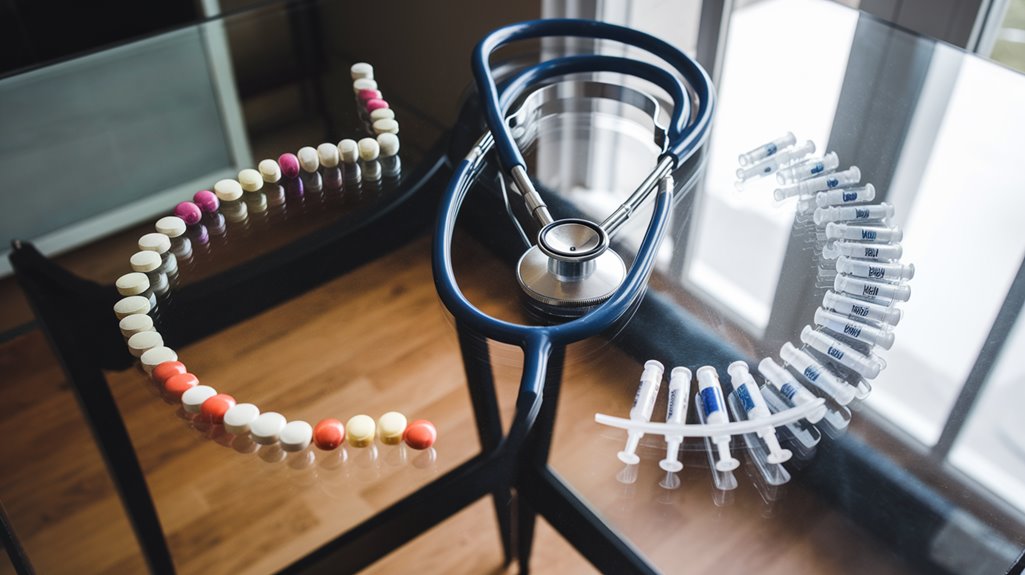
While popular discourse around weight loss injections often focuses on their primary function of reducing body weight, these medications offer a remarkable array of lesser-known metabolic benefits. You'll experience enhanced insulin production and reduced glucagon levels, leading to better blood sugar control. The medications also slow your stomach emptying, creating longer-lasting feelings of fullness.
What's particularly significant is the injection method's superior absorption rate. Unlike pills that must navigate your digestive system, injections deliver medications directly into your bloodstream, ensuring maximum effectiveness. You'll find that weekly dosing options like semaglutide and tirzepatide can achieve up to 20% weight loss while simultaneously improving your cardiovascular health and reducing chronic disease risks.
Beyond weight loss, you'll benefit from improved focus, enhanced mental well-being, and sustained health improvements. These advantages make injections a compelling option, especially when combined with lifestyle modifications.
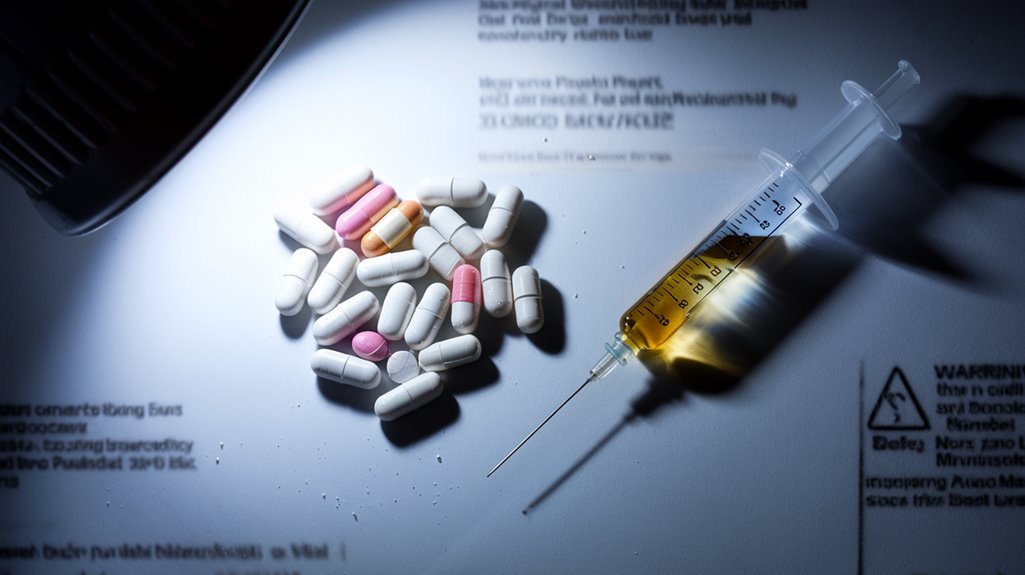
Despite the significant benefits of weight loss medications, both pills and injections carry distinct risks that require careful consideration. Oral medications typically present with hypoglycemia, gastrointestinal disturbances, and weight fluctuations. Injectable medications, particularly semaglutide, can cause localized reactions and systemic effects like body aches and nasal congestion.
While oral medications generally have fewer side effects, injectables offer better bioavailability and dose control. However, you'll need to weigh these advantages against potential complications:
Understanding these side effects is essential for making an informed decision between pills and injections, as your tolerance for specific risks may influence your choice.
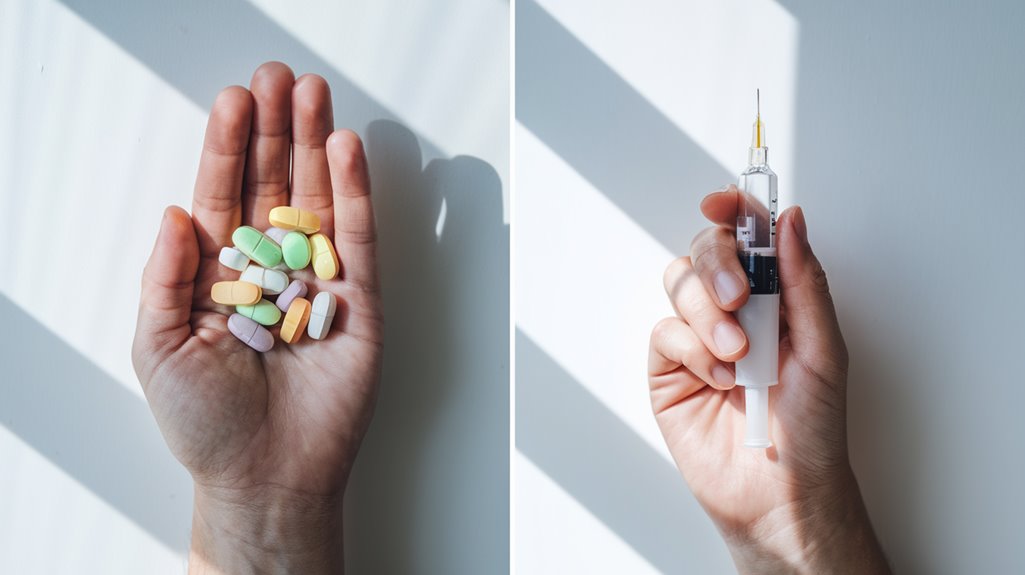
As medical technology advances at an unprecedented pace, innovative drug delivery methods are revolutionizing how patients receive their medications. You'll soon see nanotechnology-enhanced injections that target specific cells and 3D-printed pills customized to your genetic profile. These advancements will transform how you manage both acute and chronic conditions.
| Innovation | Impact on Treatment |
|---|---|
| Microchips | Controlled release monitoring |
| Biosensors | Real-time drug level tracking |
| Smart Pills | Remote compliance monitoring |
| Nanotech | Enhanced drug targeting |
| 3D Printing | Personalized dosing |
The future of medical delivery promises more effective treatments with fewer side effects. You'll benefit from gastroretentive systems that improve drug absorption and ingestible sensors that track your medication's effectiveness. For chronic conditions, you'll have access to personalized medicine tailored to your genetic makeup, while acute treatments will utilize targeted delivery systems for faster relief. These developments will make both pills and injections more efficient, safer, and precisely matched to your needs.
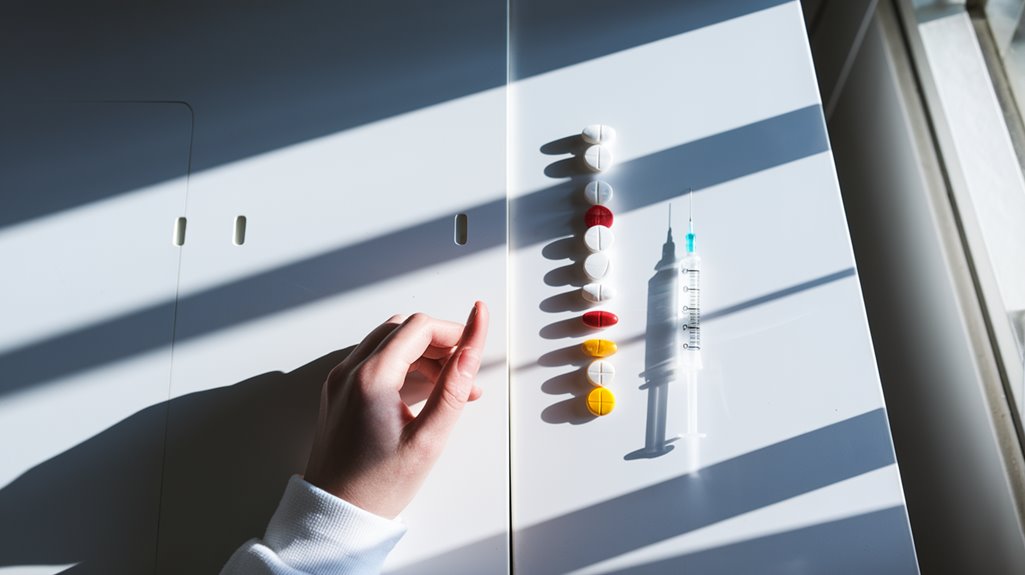
Making an informed decision between pills and injections requires a systematic evaluation of multiple factors. You'll need to assess your medical condition's severity, lifestyle requirements, and personal preferences while following your healthcare provider's guidance. Your decision should balance effectiveness, convenience, and long-term sustainability of the treatment method.
Remember that effectiveness isn't solely about the delivery method—it's about choosing an option you'll consistently follow. While injections offer precise dosing and rapid absorption, pills might be more practical for your lifestyle. Your final choice should align with both medical necessity and your ability to maintain the treatment protocol.
You've now armed yourself with the critical data to make an informed decision between pills and injections. While both delivery methods stand as pillars in modern medicine, your unique medical profile will illuminate the best path forward. Consider your priorities – speed, comfort, cost, and convenience – as compass points. Schedule a consultation with your healthcare provider to chart your course through these therapeutic waters.